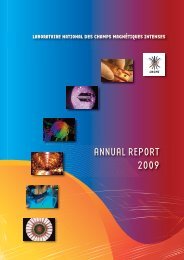Laboratoire National des Champs Magnétiques Pulsés CNRS – INSA
Laboratoire National des Champs Magnétiques Pulsés CNRS – INSA
Laboratoire National des Champs Magnétiques Pulsés CNRS – INSA
You also want an ePaper? Increase the reach of your titles
YUMPU automatically turns print PDFs into web optimized ePapers that Google loves.
The scientific contributions in this area are mainly in solid-state Physics (broad-band NMR) at very large<br />
variable magnetic fields (up to 34 T) and low temperature (a few tens of mK). They are also based on high-resolution<br />
NMR for material science at room temperature and 30 T; however, this is a starting new project.<br />
Five permanent positions of researchers, three postdocs and two students work in this area. This is a small<br />
group, which nevertheless attracts several (6) regular visitors.<br />
The production is very good and quite superior to usual standards.<br />
The themes which have been developed for solid-state Physics concern: (1) High T C superconductors Cobaltates<br />
and Pnicti<strong>des</strong>; (2) Exotic superconductivity: FFLO phase in CeCoIn 5 and Jaccarino-Peter mechanism in λ-(BETS) 2FeCl 4;<br />
(3) Quantum anti-ferro-magnets: (i) Luttinger-liquid behavior in the spin ladder CuBr 4(C 5H 12N) 2, (ii) Wigner<br />
crystallization of bosons: magnetization plateaus in SrCu 2(BO 3) 2, (iii) Bose-Einstein Condensation of triplets/bosons in<br />
Han purple BaCuSi 2O 6.<br />
The second topic, which concerns ‘classical’ NMR, has only started very recently by analyzing at 30 T, on a<br />
static ZrF 4 powder sample, the 91 Zr spectrum.<br />
Concerning the projects, which concern solid-state Physics, there are related to :<br />
- Quantum spins: Ising chain of BaCo2V2O8, NiCl2·4SC(NH2)2 compound (DTN), High-field<br />
phase transition in Volborthite.<br />
- High Tc's, cobaltates and pnicti<strong>des</strong>.<br />
- Field-induced super-conductivity.<br />
However, the main new project of this group concerns the application of very high-field NMR to ‘classical’<br />
NMR. This project should be encouraged. Indeed, there is another TGE (based on the Federation 3050), which is<br />
devoted to ‘classical’ NMR. At least ¾ of its proposals are based on quadrupolar low-gamma nuclei, which can only be<br />
recorded with very large field NMR spectrometers. The two largest fields presently available for this purpose are 21.1<br />
T (Lille) and 20 T (Orléans). Indeed, the 23.5 T magnet of Lyon is reserved for biology, which means 1 H/ 13 C/ 15 N nuclei,<br />
all spin-1/2 nuclei. Even at 21.1 T, the 1D spectra of low-gamma nuclei remain very broad with all resonances<br />
overlapping. For such broad spectra, the resolution of c.a. 1 ppm accessible at Grenoble is quite sufficient. The<br />
resolution of such nuclei is proportional to the square of the magnetic field, and thus spectra recorded at 30 T are<br />
2.25 more resolved than those recorded at 20 T.<br />
It should thus be fine for the two TGEs (LCMI, Lille and Orléans) to work together on such project of lowgamma<br />
quadrupolar nuclei. This new topic would create links between LNCMI and the large community of people<br />
working in the field of material science. In order to do so, it means for LCMI to develop double-resonance ( 1 H- 19 F/X<br />
low-gamma) MAS probes, with the shortest as possible dead-time. There are several very recent ‘tricks’ that can be<br />
used to improve such a development. This can thus be done in collaboration with the two groups (Lille and Orléans) of<br />
‘classical’ NMR.<br />
4 � 4 Molecular Magnetism<br />
- 1 professeur<br />
- 1 directeur de recherche<br />
- 1 ingénieur de recherche<br />
Besi<strong>des</strong> a nice NMR experiment on CsFe8, which displays a field-induced phase transition, most of the research<br />
on molecular magnetism is made within the High-Field RPE group. The recent arrival of a chemist researcher will<br />
boost that already well known activity on molecular magnet and will be the opportunity to develop a new activity on<br />
new materials presenting ferroelectric or even multiferroic properties.<br />
The main results to date refer to S>1 systems, where the multifrequency operation mode of the HF-RPE system<br />
is particularly suitable. For example, double Ni(II), Mn(II) or Fe(III) complexes have been studied, and their molecular<br />
configuration explored, and compared with models. These results are important in order to be able to build new<br />
molecular magnets. Biological systems have been also investigated, namely proteins with Fe-4S tetrahedras. The<br />
structure of Single Molecular Magnets which present quantum properties at low temperature has been studied.<br />
10







